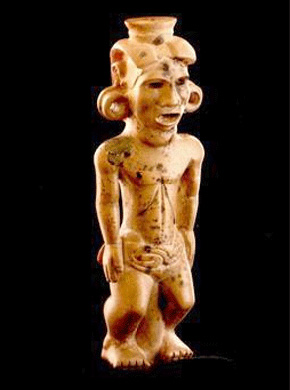CHILLICOTHE AREA
THE ADENA MOUND
When Worthington established his estate here, a 27-foot mound, inside an earth ring, stood at the foot of the hill. Finds from this mound are the reason archaeologists applied the name “Adena” to the culture which thrived in this region from about 1000 BC to AD 100. The excavations destroyed the mound; its location now lies beneath the streets and houses near the small Lake Ellensmere.
Mills’ excavations revealed this spectacular pottery pipe with the main burial: an eight-inch figure of a man wears a loincloth and feather bustle, his knees are bent as if he’s dancing. Retired Ohio Historical Society Curator Martha Otto:
This pipe is unique in that we’ve never found another one like it, carved in this form of a human – a full figured man standing with his hands at his sides, and so forth. And over the years that particular pipe, which we call the Adena Pipe, named after the site, has become kind of emblematic of the Historical Society, and of the Adena culture.
The Mound itself was typical of Adena architecture: the free-standing conical mounds, sometimes with surrounding rings and ditches, that are found throughout Ohio. Martha Otto continues:
You do get situations like in Athens County, around the Plains, where there was quite a grouping of conical mounds; the same around Charleston, West Virginia. But I think by and large, if a mound is located that it is separate from any other, usually we classify it as Adena.
The most spectacular of the Adena mounds are at Miamisburg, Ohio, and Moundsville, West Virginia, and the beautiful Conus Mound at Marietta, with its well preserved surrounding ring.

The Adena Pipe has become one of the most iconic objects in the collections of the Ohio Historical Society in Columbus.


